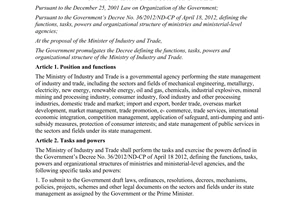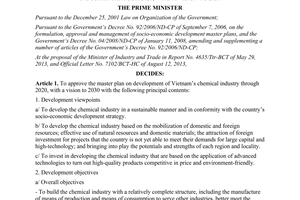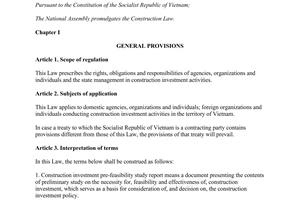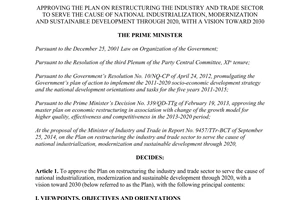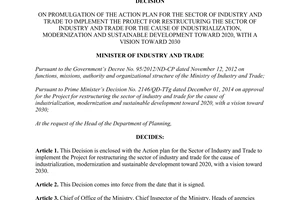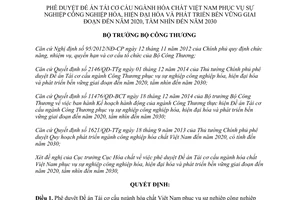Nội dung toàn văn Decision No. 8989/QD-BCT approval Vietnam chemical sector restructuring project 2020 2030 2015
|
MINISTRY OF
INDUSTRY AND TRADE |
SOCIALIST REPUBLIC
OF VIETNAM |
|
No.: 8989/QD-BCT |
Hanoi, August 25, 2015 |
DECISION
GIVING APPROVAL FOR VIETNAM CHEMICAL SECTOR RESTRUCTURING PROJECT FOR THE CAUSE OF INDUSTRIALIZATION, MODERNIZATION AND SUSTAINABLE DEVELOPMENT TOWARDS 2020 AND FOR VISIONS EXTENDED TO 2030
MINISTER OF INDUSTRY AND TRADE
Pursuant to the Government’s Decree No. 95/2012/ND-CP dated November 12, 2012 defining functions, tasks, powers and organizational structure of the Ministry of Industry and Trade;
Pursuant to Prime Minister’s Decision No. 2146/QD-TTg dated December 01, 2014 giving approval for the industry and trade sector restructuring Project for the cause of industrialization, modernization and sustainable development towards 2020 and for visions extended to 2030;
Pursuant to the Decision No. 11476/QD-BCT dated December 18, 2014 of the Minister of Industry and Trade on the issuance of the Action plan of the sector of Industry and Trade for the execution of the industry and trade sector restructuring Project for the cause of industrialization, modernization and sustainable development towards 2020 and for visions extended to 2030;
Pursuant to the Decision No. 1621/QD-TTg dated September 18, 2013 of the Prime Minister approving the Plan on development of Vietnam chemical industry up to 2020 and the vision extended to 2030;
Considering the request of the Director General of the Vietnam Chemicals Agency concerning the approval for Vietnam chemical sector restructuring Project for the cause of industrialization, modernization and sustainable development towards 2020 and for visions extended to 2030,
DECIDES:
Article 1: Approving the Project for Restructuring Vietnam chemical sector for the cause of industrialization, modernization and sustainable development towards 2020 and for visions extended to 2030 (referred to as the Project) with these primary contents:
I. STANDPOINT, DIRECTION AND OBJECTIVES
1. Standpoint and direction
- Chemical sector restructuring is a part of Industry and Trade sector restructuring, and in conformity with industrial development strategies and planning. Chemical sector restructuring shall be transformed from quantity model to quality model in a suitable structure by limiting small-scale production, developing centralized production corporations to meet domestic demand and export certain products with competitive advantage, attracting the participation of economic sectors, step by step adopting new technologies for manufacturing products with high quality and competitive price.
- During the chemical sector restructuring, enterprises and organizations, individuals participating in production process will play the leading role. Besides, ministries and authorities will direct and give assistance to create a convenient investment environment by means of promulgation and execution of policies and administrative reform to attract the investment of enterprises and economic sectors to the chemical sector.
- The chemical sector restructuring shall be performed on the grounds of sustainable development, efficient employment of natural resources and domestic materials, exploitation of potential and strength of each region and each locality.
2. Objectives
2.1. General objectives
- Develop the production on the grounds of suitable and economical employment of natural resources and adoption of modern technologies to increase value added of chemical products, produce essential products to meet domestic demand and promote export of the following products: fertilizers, rubber products, basic chemicals, petrochemical products, purity chemicals, pharmaceutical chemical products and chemicals for consumption purposes.
- Set up a suitable arrangement of productive forces according to territories to create a balanced development; establish and effectively develop centralized industrial zones, and large-scale chemical production corporations. Make plans for moving and gathering chemical factories to industrial zones for centralized management;
- Innovate, arrange and improve business efficiency of state-owned chemical enterprises; adopt new methods of business management; increase efficiency of using capital in state-owned enterprises; cut down decentralized investment without economic efficiency; withdraw non-core investments from corporations and enterprises where the state holds governing powers;
- Develop a fully-structured chemical sector, including production of means of production and means of consumption to support other industries and deeply participate in production and supply network; give priority in development of certain key branches such as petrochemistry, pharmaceutical chemistry, rubber products and basic chemicals, etc., promote the capital accumulation of economic groups engaged in the chemical sector.
2.2. Specific objectives
Increase and maintain the average growth rate of productive value of chemical industry from 14% to 16% and make 14% in 2020 and about 15% in 2030 of the proportion of the chemical industry compared to the whole industry of Vietnam.
II. CONTENT OF RESTRUCTURING
The chemical sector restructuring includes the following branches:
1. Fertilizers
- Make investment and do research to improve efficiency of use of existing types of fertilizers to enhance their usable value and higher added-value of straight fertilizer, compound fertilizers with macronutrients, secondary nutrients and micronutrients; types of fertilizers that contain plant growth substances and substances that strengthen the plant's immune system, and are suitable to various types of plants with high economic value;
- Increase research for dressing and employing poor apatite ores (grade-2 and grade-4 ores) to produce fertilizers and other chemicals; carry out full exploitation of fluorinated compounds during the apatite processing to serve other industries; ensure the efficient employment of natural resources from apatite ores;
- Urea nitrogenous fertilizer: Capacity for manufacturing urea fertilizer has exceeded domestic demand. It’s necessary to develop export markets and make plans for balancing the ratio of ammonia and urea commodities in conformity with market demand; manufacture and use urea products containing nitrogenous stabilizers;
- DAP (diammonium phosphate) and phosphate fertilizer: Producers of single superphosphate fertilizers shall be transformed step by step into producers of triple superphosphate fertilizers containing from 24 – 28% P2O5. Improve existing phosphate fertilizer producers to save raw materials and fuels, and enhance product quality. Build DAP Plant No. 3 to meet domestic demand;
- Compound fertilizers: Manufacture NPK fertilizer with secondary nutrients or micronutrients that has total content of macronutrients from 30% to 45%. Invest in production of foliar fertilizers containing macronutrients, secondary nutrients or micronutrients; compound fertilizers containing plant growth substances, substances that strengthen the plant's immune system or increase usable efficiency of fertilizers;
- Do research and make investment in ammonium sulfate factories on the grounds of output of projects for production and full exploitation of ammonia and sulfuric acid. Attach special importance to production of potassium fertilizers to meet demand for fertilizers in agricultural production;
- Promote research, development and production of organic fertilizers, bio-fertilizers and microbial fertilizers to meet more and more increasing demand for plants with high economic value and for export;
- Arrangement of enterprises: Re-organize state-owned enterprises manufacturing compound fertilizers in centralized direction with large scale. Expand scale of existing factories or build new factories manufacturing compound fertilizers to increase total capacity from 3.5 million to 4.0 million metric tons/year. Maintain and improve high-tech fertilizer factories; step by step eradicate small producers with obsolete technology and poor-quality products, etc.;
- Regional structure: Presently, fertilizer producers are arranged suitably, near sources of raw materials or balanced with demand of each region. Therefore, current regional structure may be maintained.
2. Plant protection chemicals
- Invest in production of certain eco-friendly active ingredients that eradicate harmful insects and diseases such as carbamate active ingredients, azole active ingredients and derivatives, pyrethroid and validamycin ingredients;
- Carry out in-depth investment in producers and processers of plant protection chemicals by adopting advanced technologies and replacing poisonous chemicals and organic solvents; develop new active ingredients derived from microorganism and those extracted from plants to create easy-to-use, easily decomposable and eco-friendly products;
- Give priority to producers and processors of plant protection chemicals that develop newly-processed products. Such producers and processors of plant protection chemicals should be suitably arranged in conformity with characteristics of plants, climate and soil in both three regions, Northern, Middle and Southern Vietnam, to reduce costs for transporting raw materials and finished products;
- Orientate the removal of producers of plant protection chemicals to centralized industrial zones to facilitate management and pollution control.
3. Petrochemistry
- Invest in production of resin in primary forms and synthetic rubber raw materials such as Polyethylene (PE), Polypropylene (PP), Polyvinyl Chloride (PVC), Polystyrene (PS), Acrylonitrile Butadiene Styrene (ABS), Purified Terephthalic Acid (PTA), Monoethylene Glycol (MEG) and other certain chemicals, additives and semi-finished products served for high-tech industries and manufacturing industries nationwide for the purpose of meeting demand of domestic use and export, and limiting export of raw materials;
- Carry out research on the construction of chemical production complex using input material as coal and PP and butadiene products and other products;
- Establish industrial petrochemistry complexes in association with domestic oil refinery plants.
4. Pharmaceutical chemistry
- Establish advantageous medicinal plant regions of Vietnam; invest in factories processing, extracting and separating pharmaceutical chemicals originated from tropical plants and animals, and ocean creatures; Concentrate on investment, development and production of antibiotic products and raw materials for producing essential medicines that have advantages in resources such as medicinal separation and extraction products and semi-synthetic products made of natural compounds; carry out investment in common excipients and pharmaceutical chemicals factories; factories producing third and fourth-generation cephalosporin antibiotics; and factories producing sorbitol used in Vitamin-C production;
- Encourage all economic sectors, especially non-state production organizations, to participate in development of medicinal plant cultivation and processing; attach special importance to small and medium-scale producers and processers of pharmaceutical chemistry products. The State shall initiatively carry out investment in production of high-tech chemicals and excipients that have huge demand and are essential to community health safety such as new-generation vaccines and antibiotics; and encourage foreign investors to carry out investment in these important fields;
- Encourage domestic investors to carry out technological transfer, form joint-venture and associate with foreign investors to manufacture materials and products in pharmaceutical chemistry field.
5. Basic chemicals
- Gradually adopt new technologies and expand existing producers to ensure sufficient provision of common basic chemicals such as sulfuric acid, phosphoric acid, hydrochloric acid, nitric acid, soda, ammonia and other chemicals used in industrial and civil branches;
- Carry out market research for step by step constructing and developing production of high-tech chemicals and purified chemicals to meet diverse demand of other technical and economic sectors;
- Carry out investment in research on grade-II and grade-IV apatite ore-dressing technologies. Improve technologies of producers of yellow phosphorus to ensure and increase productivity and safety in production; carry out research on phosphorous products with high economic value;
- Perform removal of chemical factories that cause pollution near residential areas to chemical industrial zones.
6. Electrochemical power source
- Carry out in-depth investment, improve product quality, increase output of common batteries and cells, and invest in production of certain types of high-grade specialized batteries and cells such as sealed batteries, solid fuel cells, nickel–metal hydride battery or Li-ion battery, new-generation batteries used in advanced electronic equipments;
- Carry out research on investment in projects supporting for electrochemistry sector and increase import substitution rate. Intensify and invest in research on technologies; carry out investment and research on specialized products that have high added value and eco-friendly technology.
7. Industrial gases
Adopt new technologies, and modern and safety equipment used in processing to meet domestic demand for common industrial gases; carry out investment in production of high-value rare gases such as helium and argon, and gradually reduce import rate of rare gases.
8. Rubber
Improve quality, diversify categories of tyres and tubes products to basically meet domestic demand and reduce proportion of imported products, and step up export of high-economic value products such as radial tyres, specialized automobile tyres, tubeless motorbike tyres, tyres and tubes of various kinds of sports bicycles and all-terrain bikes;
- Attach special importance to development of groups of technical rubber products such as conveyor belts, driving belts, washers, felts and technical rubber accessories used in other industries;
- Build association models between processers of rubber latex and producers of industrial rubber products to increase exploitation efficiency and economic value of domestic sources of rubber latex, and ensure source of raw materials used in production of industrial rubber products;
- Construct supporting policies and encourage the investment in production of materials and additives used in production of rubber products such as black coal and silicon.
9. Detergents
- Modernize existing technological lines to meet domestic demand for product quantity and quality and promote export;
- Develop cosmetics products using natural, eco-friendly and high-economic value materials and active ingredients;
- Attract investment capital in production of premium products that need high technology and large investment capital, including production of raw materials.
10. Paint & printing ink
- Expand and modernize existing paint & printing ink production facilities, adopt new technologies, improve product quality, and gradually close production facilities applying obsolete technologies;
- Carry out new investment in specialized paint products and eco-friendly paint categories such as paints without using solvents or water-based paints; carry out investment in electrostatic paints, anti-fouling paints and protective paints;
- Expand and improve capacity of materials production plants (such as alkyd resins, acrylic resins, coloring agents, etc.) used in paint & printing ink industries;
- Build a number of projects producing raw materials used in paint & printing ink industries, especially resin slabs, filler powder and solvents such as acrylic and polyurethane, and premium and specialized types of filler powder such as kaolin, CaCO3, SiO2, etc. (used to replace for TiO2 white powder and red iron oxide powder) whose source of materials in Vietnam is very rich, and types of basic petrochemical-derived solvents.
III. GENERAL SOLUTIONS ON POLICIES
1. Innovate policies and step up administrative reform to meet development demand
- Check, amend, supplement and perfect the system of legislative documents related to the chemical, investment and construction sectors;
- Make proposals for suitable policies to attract investment in high-tech projects and technological transfer projects, and make proposals for policies and route of gradual eradication of obsolete technologies; make proposals for construction of centralized chemical industrial zones that are suitably arranged in the whole country.
2. Improve planning quality, associate strategies with the establishment of plans and schemes; exercise management and supervision for greater governmental management of execution of chemical sector plans.
- Supervise the chemical sector planning and planning for branches of chemical sector to make update amendments to the planning for chemicals, fertilizers and pharmaceutical chemicals, and make new schemes for unplanned branches of chemical sector;
- Appraise the performance of investment projects in the chemical sector planning and planning for branches of chemical sector to provide orientation for attracting foreign investment in conformity with development orientation of each branch;
- Intensify inspection of the implementation of chemical sector planning; intensify supervision of quality of works as regulated by the Law on construction and relevant laws; coordinate with local authorities to inspect and control the implementation of such planning.
3. Improve efficiency in investments, production and business in state-owned enterprises
- Improve efficiency in investments, production and business in enterprises; make focus investments and concentrate capitals in key projects that follow the 5-year plan of production, business and investment approved by Prime Minister, and annual plans established by groups and corporations;
- Establish and develop trademarks for household chemicals products for the purpose of enhancing value and increasing competitive capacity of such products in domestic and overseas markets.
4. Maintain and innovate state-owned chemical enterprises
- Step up the equitization in Vinachem, chemical enterprises affiliated to Vinacomin and Petrovietnam according to approved plans; perform the diversification of ownership; and withdraw investments in non-core business sectors that have low investment efficiency and are unable to increase their scale as regulated by the Government;
- Promulgate regulations on supervision applied to state-owned business groups in chemical sector, including the following contents: inspection, auditing, and transparence and disclosure of information of their operations; public and transparent performance of their operations in natural monopoly sectors;
- Give assistance to enterprises during their equitization; carry out arrangement for enterprises, and do research on a suitable organizational model for enterprises; Diversify sources of investment capital; balance and allot capital.
5. Development of human resources
- Determine demand for human resources of branches of the chemical sector to establish plans for human resource training for the purpose of meeting requirements on qualification and professional skills;
- Establish policies for attracting and persuading excellent scientists to make contribution to the development of chemical industry;
- Construct data system for managing chemical sector human resources.
6. Scientific and technological development
- Continue the process of perfecting organizational structure of research agencies;
- Make focus investment in development of laboratories for analyzing chemicals and appraising quality of chemical products in accordance with national and international standards and technical regulations;
- Increase capacity for doing research, apply advanced techniques and technologies, carry out technological transfer, and private sector involvement in the development of science and technology; adjust structure of research works and focus on primary duties of restructuring Project.
IV. CERTAIN SPECIFIC SOLUTIONS FOR EACH BRANCH
1. Fertilizers
- Establish and perfect the national technical regulations on inorganic fertilizers and classification of superphosphate fertilizers and NPK fertilizers; perform the appraisal and grant permits to qualified producers of fertilizers as regulated; gradually eradicate small and unqualified producers of fertilizers; expedite the performance of following projects: DAP Plant No. 3, Project for Exploitation and processing of potassium salt mines in the Lao People's Democratic Republic;
- Do research and make proposals for incentive policies for projects for transforming from production of single superphosphate fertilizers to production of triple superphosphate fertilizers; SA production projects.
2. Plant protection chemicals
- Apply the preferential import tax rates to materials which are not yet produced domestically, including: carbamate active ingredients, azole active ingredients and derivatives, pyrethroid and validamycin active ingredients, etc. on the grounds of Vietnam’s WTO commitments; Apply the preferential import tax rates to machineries which are not yet produced domestically and are imported to use in production of plant protection chemicals;
- Give priority to chemical sector projects that apply new technologies, generate less wastes and produce eco-friendly products such as new active ingredients derived from microorganism and those extracted and separated from plants;
- Encourage investment in production of raw materials used in production of plant protection chemicals such as active ingredients, solvents, surfactants (emulsifiers, dispersants, absorbents and foaming agents, etc.).
3. Petrochemistry
- Make suitable use of natural gas and associated gas for developing petrochemistry sector and step up production of basic organic chemicals through petrochemistry projects;
- Construct and apply policies for prioritizing use of gas sources for petrochemistry projects to increase added value of these sources of materials.
4. Pharmaceutical chemistry
- Construct policies for supporting the investment in production of antibiotics and certain essential medicines, and projects for development and production of pharmaceutical chemical products made of rare natural resources of Vietnam; make proposals for more flexible policies on using pharmaceutical chemical products as materials for making up certain medicines;
- Encourage the performance of technological transfer and formation of joint ventures and association of foreign investors with domestic investors to manufacture materials and products in pharmaceutical chemistry field.
5. Basic chemicals
- Mobilize capital from joint ventures, partnerships and foreign investments for investing in projects that have large scale, high technologies and in-depth processing of materials used in production. Give priority to enterprises to borrow money for adopting new technologies and applying new science and techniques to their production operations;
- Apply the preferential import tax rates to materials which are not yet produced domestically or domestic production of which cannot meet demand for use; increase with permitted limit the import tax rates of finished products and products which domestic facilities can produce;
- Do research on using rare-earth materials for production of basic chemicals. Step up progress of domestic projects for production of industrial salts; carry out investment in equipment and technology for producing qualified industrial salts used in production of chemicals such as sodium hydroxide, sodium carbonate, etc.;
- Make plans for relocation of chemical production factories to industrial zones for the purpose of centralized management and reduction of environmental pollution.
6. Electrochemical power source
- Attract foreign investment in production of high-tech products, especially batteries used in the programs of automobile and motorbike import substitution, and those used in telecommunications base stations and special use vehicles;
- Maintain and develop existing trademarks, expand and look for new domestic and overseas consumption markets;
- Submit proposals to the Government for promulgating special incentive policies to projects for production of high-tech and eco-friendly cell and battery products.
7. Industrial gases
- Prioritize the development of projects applying new technologies, generating less waste and producing eco-friendly products; applying energy saving solutions, increasing the efficiency of new materials;
- Prioritize the production of rare gases such as helium and argon, etc. which are used in high-tech sectors;
- Make plans for relocation of production factories to industrial zones for the purpose of centralized management and reduction of environmental pollution.
8. Rubber
- Facilitate and encourage economic sectors to engage in development of rubber products, especially facilitate and encourage foreign investors that have capital and technological advantage to participate in production of high-tech products such as automobile tubes and motorbike tubes made of synthetic resin (butyl rubber), natural rubber and other technical rubber products; increase content of natural rubber in rubber products;
- Do research on changing structure of natural rubber products that have been preliminarily processed by balancing groups of products, focusing on products with competitive advantages and carrying out stable provision of raw materials for domestic and overseas producers of rubber products;
- Apply methods to strictly control the import of tyres and tubes via cross-border trade, inspect the declaration of imported prices, and make plans for prevent the import of counterfeits and poor-quality products into Vietnam market.
9. Detergents
- Establish and execute research works on developing new detergents, especially eco-friendly products which are suitable to Vietnam conditions;
- Do research and make proposals for policies supporting domestic enterprises to carry out investments in production of detergent products and certain materials.
10. Paint & printing ink
- Prioritize and encourage non-state economic sectors to invest in development of categories of paint & printing ink products such as special-use, high-added value, high-tech and eco-friendly paints; apply incentive policies to development of electrostatic powder paints, water-based wood paints or wood paints whose content of volatile organic compounds (VOC) is lower than 50%;
- Encourage enterprises to establish plans and strategies on trademark development and development of product consuming system;
- Engage in intensive training and promote capacity of scientific and technological researchers of specialized research institutes, and technical, technological and management divisions of paint & printing ink enterprises;
- Prioritize the development of projects applying new technologies and energy saving solutions, producing eco-friendly products, increasing the efficiency of new materials and reusing all types of waste generated during the processes of production.
Article 2. Implementation
1. Designation of organizations to implement the Project
General Directorate of Energy, Departments and Bureaus of Ministry of Industry and Trade base on their functions, mission and authority to lead and coordinate with units inside and outside Ministry of Industry and Trade, and Departments of Industry and Trade of central-affiliated cities and provinces to provide counsels for Minister of Industry and Trade’s steering and guiding of the enforcement of the Project. To be specific:
a) Vietnam Chemicals Agency
- Frequently follow and monitor the implementation of the Project; carry out specialized inspection on fulfillment of investment requirements and state management of projects within its powers;
- Coordinate with groups and associations in chemical sector, and relevant authorities to check and control investment objectives, clearly determine focuses and main points for investment and direct the adjustment of investment structure according to each region and in consistent with the approved orientation;
- Lead the inspection of the implementation of the Project and summarize information and report to the Minister of Industry and Trade for submitting to the Prime Minister for considering and making amendments to the Plan on development of Vietnam chemical industry; Lead the construction and provide advices for Minister of Industry and Trade’s promulgation of specialized schemes; provide counsels for promulgation of specialist legislative documents; do research and propose policies supporting investment and development in chemical sector for efficiently implementing the Project;
- Response to difficulties concerning the implementation of the Project and make proposals for amending and supplementing the Project in case of need.
b) General Directorate of Energy: Coordinate with the Vietnam Chemicals Agency to follow, inspect and guide enterprises in petrochemistry branch to implement restructuring contents of the Project; direct the Vinacomin to supply coal materials to fertilizer producers, do research on suitable use of anthracite coal, and avoid waste of the national rare resources.
c) Planning Department and Finance Department: Supervise the investment of enterprises within their powers; lead the suggestion of policies for attracting the investments in projects for production of high-tech products, attracting capital and private sector involvement in investments in prioritized sectors, etc. The Finance Department shall coordinate with the Vietnam Chemicals Agency to do research and make proposals for adjusting the import tax rates to chemical and fertilizer products in conformity with each period; Organization and Personnel Department: Lead and coordinate with the Vietnam Chemicals Agency to provide advices to the Minister’s supervising and guiding for arranging and organizing structure of chemical enterprises according to the Project's contents.
d) Science and Technology Department: Lead the establishment and coordinate with the Vietnam Chemicals Agency and relevant units to provide advices to the Minister of Industry and Trade's promulgation of documents, technical standards and processes, eco-technical norms and technical corridor in the chemical sector, guide the application and development of new advanced technologies in the production of chemical products.
dd) Regional Market Department and Trade Promotion Department: Initiatively look for industrial and commercial investment partners, give assistance for technological transfer from territories, regions, and economic organizations within their powers; give assistance to export of chemical products.
e) Human Resource Development Department: Lead and coordinate with the Vietnam Chemicals Agency to provide advices to the Minister's making orientation for training qualified officers and technicians in the chemical sector in conformity with the Plan on development of Vietnam chemical industry.
g) Legal Affairs Department: Lead and coordinate with the Vietnam Chemicals Agency to appraise, control, systemize, inspect, unify and follow the enforcement of legislative documents related to the Chemical sector.
h) Heavy Industry Department shall follow the enforcement of the Plan for surveying, exploiting, processing and using apatite ores up to 2020 and extended to 2030; Regulations on cooperation in surveying, exploiting, processing and using apatite ores, to ensure resources of apatite materials used in production of fertilizers.
i) Societies and Associations strengthen their roles of connecting enterprises' cooperation with the Ministry of Industry and Trade in suggesting policies on development of chemical products.
k) Enterprises in the chemical sector:
- Effectively enforce the State policies and restructuring contents of the Project. Step up joint venture and association in production from input to processing and selling products; carry out investment in innovating production process, adopting new technologies and equipment to increase efficiency of production, business and employment of resources.
- As for state-owned enterprises: Vinachem shall enforce the restructuring Project approved by the Prime Minister under Decision No. 2097/QD-TTg dated December 28, 2012 of the Prime Minister giving approval for Vinachem’s restructuring Project for stage 2012 – 2015. Other economic corporations and enterprises shall perform the restructuring as assigned in Decisions approved by competent authorities.
2. Report policies
State-owned business groups in the Chemical sector submit reports of the implementation of the Project to the Vietnam Chemicals Agency, the General Directorate of Energy, Departments and Authorities of the Ministry of Industry and Trade by the 15th of December each year. The Vietnam Chemicals Agency summarizes information and reports to the Ministry's Leadership on the results of the implementation of the Project by the 15th of January in the following year.
Article 3. This decision takes effect from the date of signing.
Article 4. Office Manager of the Ministry, General Director of Vietnam Chemicals Agency, Heads of units named in Article 2 and relevant chemical enterprises are responsible for executing this Decision./.
|
|
MINISTER |
------------------------------------------------------------------------------------------------------
This translation is made by LawSoft and
for reference purposes only. Its copyright is owned by LawSoft
and protected under Clause 2, Article 14 of the Law on Intellectual Property.Your comments are always welcomed
